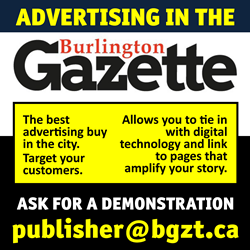 By Pepper Parr
By Pepper Parr
March 28th, 2023
BURLINGTON, ON
It goes back to 2009, long time for a Master Plan to be developed and presented to Council. The document providing a 20-year strategic framework for the development and enhancement of parks, recreation and cultural facilities and services has been used to guide city capital budgets, development charge studies, and overall, to enhance our services and meet the needs of our growing and changing community.
The document is a solid look at where Parks, Recreation and Culture staff think has to be done. Document is riddled with acronyms.
Excellent progress has been made in the implementation of the 2009 plan.
Notable projects completed over the last twelve years include:

The Skyway Arena in the east end of the city is under construction.
Recreation Facilities
Haber Community Centre
Mountainside Recreation Centre Revitalization
Angela Coughlan, Centennial and Aldershot Major Pool Renewals
Nelson Outdoor Pool and Splash Park Re-Build
Central Arena Renovations and Accessibility Upgrades
Skyway Community Centre and Arena Re-Build (in progress)
Mountainside Outdoor Pool Re-Build (in progress)
New Community Centre (former Bateman H.S. – in progress)
Parks

A first look at what was being proposed as a Beachway Master Plan. It meant a community would be destroyed and perfectly good houses demolished.
City View Park Development Phase 1
Sherwood Forest Park Renewal Phase 1
Norton Park and Alton Neighbourhood Park Developments
Burloak Park Re-development (ongoing)
Lowville Park Enhancements
New Splash Pads, Skateparks, Leash Free Parks and Community Gardens
Community Trails Strategy and Implementation
Beachway Park Master Plan
LaSalle Park Marina Wavebreak

Joseph Brant Museum: The house got lifted up and put on top of a little hill with the museum under the hill.
Cultural Facilities
New Haber Branch Library
Appleby Branch Library Relocation to new Community Centre (former Bateman H.S. – in progress)
Joseph Brant Museum Expansion
Cultural Action Plan
Public Art Initiatives
Strategy/process
Over the past year, staff have worked on the Parks Provisioning Master Plan which is now complete and tabled for Council’s consideration. The next important piece of work is the update of the 2009 PRCAMP. Both initiatives are critical in shaping the future of parks, recreation and cultural services. The table below explains the difference between the two master plans at a high level.

Initiative Focus Timeline
Parks Provisioning Master Plan (PPMP) Parkland service level (land base needs). Goal to ensure adequate public greenspace for future generations. Completed March 2023
PRCAMP Update Determine long term needs for new recreational facilities as well as revitalization and enhancement of existing assets. Q2 2023 to
Q2 2024
Overall, the goal of the PRCAMP update is:
To provide a 20-30 year strategic framework for the development and enhancement of city parks, recreation and leisure services that will contribute to the health, well-being and quality of life for all citizens of Burlington. The plan will be driven by existing and forecasted data, influenced by community needs, and informed by industry leading best practices.
Strategic Context for the PRCAMP Update
to re-evaluate community needs and priorities for parks, recreation and cultural services for the next 20-30 years. The biggest change is the projected growth: the city will grow to over 260,000 by 2051. In comparison, the 2009 PRCAMP was based on a build out population of under 200,000 by 2031 as per the Region’s “Best Planning Estimates” at the time. This projected growth will have a significant impact on parks, recreation and cultural services.
Other strategic factors that will be considered

Lawn Bowling Club is right beside the Seniors Centre.
Shifting demographics and a desire for an age friendly and inclusive community
New trends and needs for recreation and leisure services
Impacts of new provincial legislation on funding for recreation services
Land availability for more facilities and services
Optimizing the capacity and functionality of existing assets and resources
Striving for accessible and affordable services
Achieving a balanced array of recreational opportunities and services
Financial pressure of maintaining existing assets while planning for new facilities
Changing attitudes on recreation participation due to pandemic and economic factors
Exploring partnerships and available community resources to meet community recreational needs
Establishing appropriate and achievable service levels to meet community needs and expectations
Assessing the involvement of the private sector in recreation service delivery
Alignment to other corporate policies and plans including the Framework for Community Recreation, Parks Provisioning Master Plan, Urban Forest Master Plan, Integrated Mobility Plan, Climate Action Plan, Asset Management Plan, Cycling Master Plan, Community Trails Strategy, Vision to Focus.
Provision of services in the Aldershot, Burlington and Appleby Major Transit Station Areas (MTSA’s). These new compact urban communities will account for a large portion of the city’s overall growth and will require creative new ways of integrating meaningful and accessible recreational services for residents and employees. Convenient access to high quality local parks and diverse recreational opportunities is a key attribute of the “complete and healthy community” concept which is our vision for the MTSA’s. This will be a significant focus for the PRCAMP Update.
PRCAMP Scope
The PRCAMP Update will determine the need for new city recreation and leisure facilities as well as revitalization of existing assets for a 20-30 year period. The facility types that will be reviewed as part of the master plan study are listed in the table below, however other needs may be identified.

 Indoor Facilities Outdoor Facilities
Indoor Facilities Outdoor Facilities
Recreation:
Arenas/Ice Pads
Indoor Pools
Multi-Use Community Centres (gymnasiums and multi-purpose rooms)
Age-Specific Program Centres (Seniors and Youth Centres)
Culture:
Smaller Cultural Program Centres (Music Centre, Student Theatre)
Integrated cultural components & uses within multi-use community centres Parks:
Sports Fields
Playgrounds
Tennis Courts
Pickleball Courts
Basketball/Multi-Purpose Courts
Skate Parks (major and minor)
Splash Pads (major and minor)
Outdoor Pools
Outdoor Skating
Leash Free Dog Parks
Community Gardens
Bocce
Disc/Frisbee Sports
Fitness Equipment
Park Amenities (water fountains, shade, seating, washrooms, and park lighting)
Event/Festival spaces
Casual open spaces
Other emerging needs (Cricket)
Types of Recommendations
Service Level Targets (e.g., 1 ice pad per x thousand residents)
New Facility Needs (location, timing, cost, prioritization)
Major Renewal/Revitalization/Expansion (timing, cost, prioritization)
Facility Re-Purposing (timing, cost, prioritization)
Partnership Initiatives
Facility Consolidations (e.g., arena twinning, library/community centre mergers)
Facility Leases
Leveraging available community resources and assets
Strategic Acquisitions (land and facilities)
New policies, strategies, and standards
While the PRCAMP Update will be a comprehensive study, there are a number of items that will be out of scope since these items have their own focused planning and business processes.
Out of Scope:

The trail from Spencer Smith Park that leads to the canal is something every Burlington resident treasures.
Routine life cycle renewal (e.g., flooring, roof, mechanical components).
Trails – Community Trails Strategy will be refreshed in 2025.
Cycling – Cycling Master Plan recently approved.
Major Cultural Venues – The city is well served in this area through significant investments over the past 10-15 years.
Municipal Golf Course – Subject to specific business reviews
Heritage Buildings – E.g., LaSalle Pavilion, Paletta Mansion. Require focused business reviews.
Joint Ventures – These community driven initiatives accommodate specialized recreational interests and programming, over and above the City’s typical service provisions. Joint Venture initiatives are evaluated on a case- by-case basis. The City will be undertaking a broad governance accountability review of city-affiliated service organizations including Joint Ventures (JV) and Agencies, Boards and Commissions (ABC).
PRCAMP Work Plan
The following table provides a high level workplan for the PRCAMP Update.

Phase Work Activities
Project Planning
Q1 2023 o Data collection
Project Structure – Steering Committee, Project Team
RFP – Hire Planning Consultant
Situation Analysis
Q2 2023 o Review relevant policies and plans
Review current levels of service and benchmark with other municipalities
Assess non-municipal recreation services in the city
Assess functionality, capacity and utilization of existing city facilities
Review current demographic profile
Review development and population growth forecasts
Review trends in recreation and leisure participation and facility development
Understand partnership models that support service delivery
Phase Work Activities
Community Engagement
Q3 to Q4 2023 o Community and user group surveys
Stakeholder focus groups
Public Information Centres
Council interviews, workshop
Identification of key findings and strategic themes
Q4 2023 to Q2 2024 o Develop recommendations and strategies
Internal review and consultation
Prepare reports
Opportunity for public review and comment
Seek Council approval

As a head start to this project, work has already started on various tasks in the Situation Analysis Phase including data collection and an analysis of current service levels, capacity, utilization, and distribution of existing recreational assets.
Next Steps
Staff are in the process of retaining a multi-disciplinary consulting team to lead this project. The award of the contract is anticipated in early April. All data and background research work completed to date will be handed over to the new consultant.
Total Financial Impact
The will determine the need for new city recreation and leisure facilities and revitalization of existing facilities needs over a long-term horizon of 20-30 years.
The Master Plan team will come forward in 2024 with a prioritization of capital needs, associated costing, and timing.
Staff will be reporting back on the City’s multi-year community investment plan in Q4 2023 to include completed master plans to date: Integrated Mobility Plan, Fire Master Plan, Transit Master Plan), and overview of funding options resulting from Health report, Bill 23 Impact Analysis, new park dedication by-law, CBC and DC updates, etc. The MCIP will provide a preliminary financing strategy to assist in meeting the objectives of the master plans completed to date and will set the stage for financing future master plans, such as the Parks, Recreation and Culture Master Plan which is scheduled for completion in 2024.
The MCIP will continue to be refined to encompass changes to investment opportunities subject to completion of master plans, funding opportunities and city priorities.
Source of Funding
The PRCAMP Update has an approved budget of $200,000 in capital account PR0205 (Parks and Open Space). Most of the budget will be used for consultant fees. Other minor expenses include advertising, mail-outs, printing, and meeting expenses.
Other Resource Impacts
The master plan will involve staff from many Departments on various committees and teams including:
Recreation, Community and Culture (*Lead Department)
Engineering Services (Parks Design and Construction, Asset Planning, Geomatics)
Finance
Roads, Parks and Forestry
Corporate Communications and Engagement
Community Planning
Climate Implications
New weather patterns are certainly affecting recreational services including more rain and extreme storms, heat waves, higher UV index, and milder winters.
The need for more shade and shelters, water fountains, water play features to cool off, better field drainage, more reliable playing surfaces like artificial turf, and refrigerated outdoor skating surfaces are potential responses to climate change.
Finally, the protection and enhancement of green spaces and vegetation is also critical in reducing the urban heat island effect, slowing stormwater runoff and erosion, improving air quality, supporting local biodiversity and urban wildlife.
Engagement Matters:
A robust community engagement program will be implemented to get the broadest community perspectives on sport, recreation and cultural service needs. The engagement program will be finalized once the successful consultant is selected.
A communication plan will be developed to support the engagement program and ensure a high level of community awareness of the master plan initiative and opportunities for getting involved.
Council will be made aware of all community engagement opportunities before the public is notified. The community engagement will also help to inform the programmatic direction, use and functional design of the former Bateman H.S. Community Centre, and ensure that it aligns with broader community needs for recreation, arts and cultural programs and services.
Conclusion:
Once completed, the updated master plan will inform our multi-year community investment plan, future capital budgets and development charge reviews.
The recommendation from the Standing Committee will go to Council April 18th



















“refrigerated outdoor skating surfaces”
Haven’t they heard there is a climate change emergency?